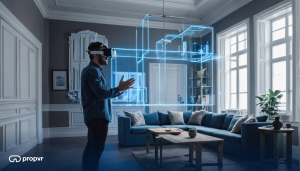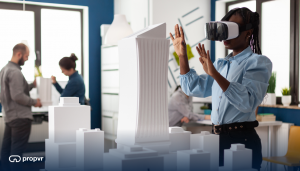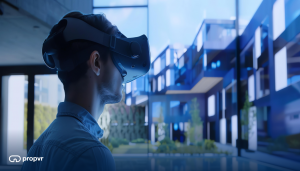Introduction
Staying ahead of the curve is essential in the rapidly evolving real estate market. Augmented Reality (AR) transforms how properties are showcased, offering an immersive experience that traditional methods simply cannot match. PropVR is at the forefront of this revolution, providing cutting-edge AR solutions that elevate property showcases to new heights. This technology enhances the buying experience and gives real estate professionals a competitive edge.

What is Augmented Reality?
Augmented Reality overlays digital information onto the real world, creating an enhanced view that can be experienced through devices like smartphones, tablets, and AR glasses. In real estate, AR allows potential buyers to visualise properties in unprecedented detail, from viewing furnishings in a space to exploring different design options. This technology bridges the gap between imagination and reality, enabling a deeper connection with the property.
How PropVR Utilizes AR in Real Estate

PropVR leverages AR to create interactive and engaging property showcases. Here’s how:
Interactive Property Tours
Virtual Walkthroughs: With PropVR, potential buyers can take interactive tours of properties, exploring every nook and cranny without physically being there. This saves time and broadens the reach of property listings. For example, a buyer can virtually walk through a property in another city, experiencing the layout and flow of the space as if they were there in person.
Detailed Inspections: Buyers can focus on specific areas of interest, such as kitchen finishes or bathroom fixtures, providing a level of detail that static images cannot offer.
Customizable Visualizations
Personalization: PropVR’s AR technology allows users to customize properties in real time. They can change wall colours, add furniture, or even see how an extension might look, providing a personalized experience. For instance, a family considering a home purchase can visualize how their existing furniture would fit into a new space or experiment with different décor styles.
Renovation Planning: Buyers can see potential renovations before purchasing, such as how a converted attic might look or the impact of removing a wall to create an open-concept living area.
Enhanced Marketing Materials
AR-Powered Brochures: AR-powered brochures and flyers offer an engaging way to present properties. Scanning a QR code can bring a static image to life, showcasing the property in 3D. This adds a dynamic element to marketing materials, making them more interactive and appealing.
Immersive Open Houses: Virtual open houses using AR can attract more attendees. Potential buyers can explore the property from the comfort of their homes, which is especially beneficial for international clients or those with busy schedules.
Benefits of Using AR in Real Estate

Increased Engagement
Captivating Experiences: AR experiences are highly engaging, capturing the attention of potential buyers more effectively than traditional photos or videos. Interactive elements make the property exploration process fun and memorable.
Higher Retention Rates: Engaging content tends to be remembered longer, increasing the likelihood that potential buyers will return to the listing.
Better Decision Making
Realistic Visualization: Buyers can visualize the property as their own, making it easier to decide on a purchase. They can see how their furniture will fit and how they can personalize the space.
Informed Choices: By seeing detailed and accurate property representations, buyers can make more informed decisions, reducing the likelihood of post-purchase regret.
Competitive Advantage
Differentiation: Offering AR experiences can set real estate agents apart from their competitors, attracting more clients. This cutting-edge technology demonstrates innovation and a commitment to providing the best possible service.
Broader Reach: Properties with AR experiences can attract a wider audience, including tech-savvy buyers and those interested in a modern, convenient buying process.
Use Cases and Examples
Residential Real Estate
New Developments: Imagine walking through your future home before it’s even built. Developers can offer potential buyers the chance to explore new homes using PropVR’s AR technology. Buyers can virtually tour different floor plans, visualize custom finishes like flooring and cabinetry, and see how their choices will look in the space. This not only helps in making informed decisions but also creates a strong emotional connection to the property.
Luxury Properties: High-end properties can be marketed globally with AR. International buyers can take detailed virtual tours, exploring the property from every angle without travelling. Exclusive virtual showings can highlight unique features, offering a personalized experience that leads to quicker sales.
Commercial Real Estate
Office Spaces: Businesses searching for office space can use AR to visualize different layouts and configurations. PropVR enables companies to see how various setups, such as open-plan offices versus private cubicles, would work. This interactive planning helps businesses find the best fit for their needs, speeding up decision-making.
Retail Properties: Retailers can use AR to plan store layouts and merchandising strategies. Visualizing the space in 3D helps understand flow and functionality, ensuring that the design maximizes customer engagement and sales.
Rental Properties
Apartment Listings: Property managers can use AR to provide virtual tours of rental units, attracting tenants from a broader geographic area. Prospective tenants can thoroughly explore the property, helping them make decisions quickly and confidently.
Vacation Rentals: Vacation rental properties can be showcased in immersive detail. Travelers can explore accommodations virtually, ensuring they choose a property that meets their expectations. This can lead to higher booking rates and satisfied customers.
Conclusion
The integration of Augmented Reality in real estate is no longer a futuristic concept; it’s happening now with PropVR. By embracing AR, real estate professionals can provide more affluent, more immersive property showcases that captivate buyers and accelerate sales. Elevate your property listings with PropVR and step into the future of real estate marketing. The ability to offer detailed, interactive, and personalized property tours will enhance the buying experience and position you as a leader in the competitive real estate market.
